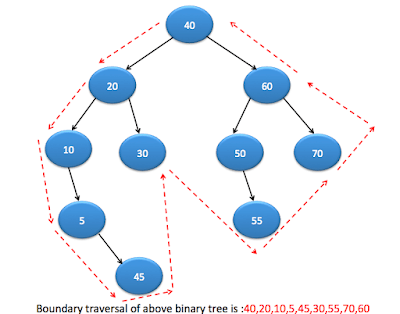Table of Contents
If you want to practice data structure and algorithm programs, you can go through 100+ java coding interview questions.
In this post, we will see boundary traversal of binary tree in java.
Lets understand boundary traversal of binary tree with example:

If you look closely to above diagram, boundary traversals can be divided into three essential parts
- Print left edge nodes (Excluding leaf nodes)
- Print leaf nodes
- Print right edge nodes (From bottom to top)
Print left edge nodes (Excluding leaf nodes)
If you define boundary for left part, it is nothing but left child if present, otherwise right child.
|
1 2 3 4 5 6 7 8 9 10 11 12 13 14 15 16 17 18 19 20 21 22 23 |
private static void printLeftEdgeNodes(TreeNode root) { if(root==null) return; // if leaf node, ignore while printing edges if(root.left==null && root.right==null) return; System.out.print(root.data+" "); // If left is null, right will be the boundary edge. if(root.left==null) { printLeftEdgeNodes(root.right); } else { printLeftEdgeNodes(root.left); } } |
Print leaf nodes:
Its pretty simple operation. Whenever you encounter leaf node, print it.
|
1 2 3 4 5 6 7 8 9 10 11 12 13 14 |
private static void printLeafNodes(TreeNode root) { if(root==null) return; if(root.left==null && root.right==null) { System.out.print(root.data+" "); return; } printLeafNodes(root.left); printLeafNodes(root.right); } |
You may also refer print leaf nodes of binary tree.
Print right edge nodes (From bottom to top) :
If you define boundary for right part, it is nothing but right child if present, otherwise left child. As we need to print bottom up, we will print the node while returning back from recursion stack.
|
1 2 3 4 5 6 7 8 9 10 11 12 13 14 15 16 17 18 19 20 21 22 23 24 |
private static void printRightBottomUp(TreeNode root) { if(root==null) return; // if leaf node, ignore while printing edges if(root.left==null && root.right==null) { return; } if(root.right!=null) { printRightBottomUp(root.right); } else if(root.left!=null) { printRightBottomUp(root.left); } System.out.print(root.data+" "); } |
Complete java program combining above three parts:
|
1 2 3 4 5 6 7 8 9 10 11 12 13 14 15 16 17 18 19 20 21 22 23 24 25 26 27 28 29 30 31 32 33 34 35 36 37 38 39 40 41 42 43 44 45 46 47 48 49 50 51 52 53 54 55 56 57 58 59 60 61 62 63 64 65 66 67 68 69 70 71 72 73 74 75 76 77 78 79 80 81 82 83 84 85 86 87 88 89 90 91 92 93 94 95 96 97 98 99 100 101 102 103 104 105 106 107 108 109 110 111 112 113 114 115 116 117 118 119 120 121 |
package org.arpit.java2blog.binarytree; public class BinaryTreeBoundaryTraversal { public static class TreeNode { int data; TreeNode left; TreeNode right; TreeNode(int data) { this.data=data; } } public static void boundaryLevelTraversal(TreeNode root) { System.out.print(root.data+" "); printLeftEdgeNodes(root.left); printLeafNodes(root); printRightBottomUp(root.right); } private static void printLeafNodes(TreeNode root) { if(root==null) return; if(root.left==null && root.right==null) { System.out.print(root.data+" "); return; } printLeafNodes(root.left); printLeafNodes(root.right); } private static void printRightBottomUp(TreeNode root) { if(root==null) return; // if leaf node, ignore while printing edges if(root.left==null && root.right==null) { return; } if(root.right!=null) { printRightBottomUp(root.right); } else if(root.left!=null) { printRightBottomUp(root.left); } System.out.print(root.data+" "); } private static void printLeftEdgeNodes(TreeNode root) { if(root==null) return; // if leaf node, ignore while printing edges if(root.left==null && root.right==null) return; System.out.print(root.data+" "); // If left is null, right will be the boundary edge. if(root.left==null) { printLeftEdgeNodes(root.right); } else { printLeftEdgeNodes(root.left); } } public static void main(String[] args) { // Creating a binary tree TreeNode rootNode=createBinaryTree(); System.out.println("Boundary traversal of binary tree will be:"); boundaryLevelTraversal(rootNode); } public static TreeNode createBinaryTree() { TreeNode rootNode =new TreeNode(40); TreeNode node20=new TreeNode(20); TreeNode node10=new TreeNode(10); TreeNode node30=new TreeNode(30); TreeNode node60=new TreeNode(60); TreeNode node50=new TreeNode(50); TreeNode node70=new TreeNode(70); TreeNode node5=new TreeNode(5); TreeNode node45=new TreeNode(45); TreeNode node55=new TreeNode(55); rootNode.left=node20; rootNode.right=node60; node20.left=node10; node20.right=node30; node60.left=node50; node60.right=node70; node10.right=node5; node5.right=node45; node50.right=node55; return rootNode; } } |
When you run above program, you will get below output:
|
1 2 3 4 |
Boundary traversal of binary tree will be: 40 20 10 5 45 30 55 70 60 |
Java Binary tree tutorial:
- Binary tree in java
- Binary tree preorder traversal
- Binary tree postorder traversal
- Binary tree inorder traversal
- Binary tree level order traversal
- Binary tree spiral order traversal
- Binary tree reverse level order traversal
- Binary tree boundary traversal
- Print leaf nodes of binary tree
- Count leaf nodes in binary tree
- get maximum element in binary tree
- Print all paths from root to leaf in binary tree
- Print vertical sum of binary tree in java
- Get level of node in binary tree in java
- Lowest common ancestor(LCA) in binary tree in java
Please go through java interview programs for more such programs.



node 45 is wrongly inserted into the tree in example.
Hi Rich,
It is binary tree not a binary search tree, so it does not matter where are you going to insert node 45.